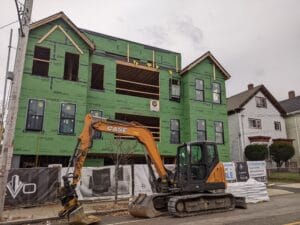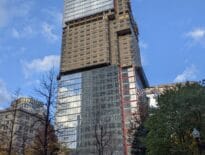
A condominium development under construction in Chelsea. City officials there had contemplated banning new apartments for five years while developing incentives for affordable home ownership construction. Photo by James Sanna | Banker & Tradesman Staff
Roy Avellaneda, president of the Chelsea City Council, thought his idea was pretty straightforward: Impose a five-year moratorium on construction of new rental properties in the city to give councilors time to re-write zoning laws to promote home ownership.
The ordinance’s ultimate goal, Avellaneda argued, was to get developers to construct more housing units in Chelsea that lower-income residents could actually buy and own, instead of rent, and thus allow them to build long-term wealth in the process.
But Avellaneda recently yanked the ordinance from consideration after the city’s legal counsel informed him a moratorium would be legally difficult to implement.
“I tried,” said Avellaneda. “But we’re not giving up. We’re going to look at other ways to promote home ownership in Chelsea.”
And so goes the latest push to increase home ownership in Massachusetts, this time via the construction of more for-sale housing units, a task housing advocates and developers alike say is easier said than done.
The issue of rental-versus-ownership construction has recently become a flashpoint in the overall debate over how to boost home ownership among lower-income residents, particularly among Black Bay Staters, who historically have had a much lower rate of home ownership than whites in Greater Boston: 36 percent versus 67 percent, according to a recent National Association of Realtors report.
Many say that ownership disparity is one of the largest, if not the largest, reasons why there’s such a huge racial wealth gap in the region. In 2015, a Federal Reserve Bank of Boston study showed that the median net worth for white households in Greater Boston was $247,500, compared to just $8 for Black households.
Subsidies Favor Rental Projects
In recent years, various community groups, banks and real estate organizations have proposed a number of plans to boost home ownership among Black households, including lowering down-payment and credit score requirements, as well as providing lower mortgage interest rates, in order to make it financially more feasible for people to buy homes.
But there’s also been a recognition that the actual supply of new affordable homes for sale needs to be increased.
Gov. Charlie Baker and MassHousing recently launched the $60 million CommonWealth Builder Program, aimed at providing subsidies to support the construction of new, single-family homes and condominiums in the state’s 26 Gateway Cities and in other areas of the state that are still moderately priced, but which don’t carry deed restrictions like traditional affordable units. The program is also set to get a $115 million boost from the state’s allocation of federal pandemic aid under a deal announced by legislative leaders last week.
Housing advocates and developers have praised CommonWealth Builder as a step in the right direction when it comes to increasing the stock of affordable new condos and single-family homes for sale in Massachusetts.
“Construction of affordable housing simply doesn’t work without subsidies,” said Larry Curtis, president and managing partner of Winn Development, which over the decades has built, rehabbed and purchased thousands of condo and apartment units in the region, most of them affordable and workforce-price units. “We welcome the recent home-ownership push, but we need more resources.”
But even if the state and federal governments significantly increased subsidies for home-ownership programs, industry experts say switching from building apartments to ownership units still faces major obstacles.
“It’s not like turning a switch from rental to ownership units,” said Elliot Schmiedl, director of home ownership at the Massachusetts Housing Partnership, a quasi-public entity focused on providing more affordable housing across the state. “There are key differences between rental and ownership housing.”
Lenders Warry of Ownership Projects
Among those differences are the levels of government subsidies and private-sector financing for rental units versus home-ownership housing.
Traditionally, rental properties have received far more subsidies from government entities than home-ownership programs, industry experts agree. Those hefty subsidies have thus encouraged, and allowed, private developers to pursue affordable apartment developments more aggressively than home-ownership projects.
“They’re tried-and-true programs,” said Rafael Mares, executive director of The Neighborhood Developers, a nonprofit community development corporation serving Chelsea, Revere and Everett.
Then there’s the private financing side of the issue.
Multifamily rental projects are considered safer loan bets by banks and other financiers due to the numerous subsidy programs available and the fact apartment units usually start generating revenue, via rent payments, soon after constriction is finished.
But multifamily ownership developments are more sensitive to economic cycles. After construction, it can sometimes take months, if not years, for developers to sell off newly built condos and single-family homes, depending on economic conditions at the time.
As result, private lenders tend to require more upfront equity from developers for ownership projects. In addition, most loan agreements require that lenders get paid off first with new revenues, forcing developers to often wait years before they can recoup their money.
“The risks are greater with ownership projects,” said Tom O’Brien, managing director and chief executive of HYM Investment Group, which is currently redeveloping the old Suffolk Downs site in East Boston and the Government Center garage in downtown Boston. “The market for rental [developments] is very robust right now. But it’s a higher-risk environment for condos.”
“When it comes to larger multifamily projects, it is difficult in general to build for-sale product because of pre-sale requirements, tax treatments [and other factors],” said Ted Tye, managing partner at National Development. “With rental, it’s much easier to incorporate affordable rental units within a larger building. Financing is indeed easier and there is no market risk of having to sell units.”
20 Percent More Expensive
Then there’s the differences between average renters and average homebuyers.
Whether Black or white, the average homebuyer is generally more discerning than renters about the quality of new construction. After all, they’re going to be plunking down considerably more money for a home than just one month’s rent and a security deposit, experienced industry hands say.
Homebuyers tend to view ownership as a long-term investment, not a month-to-month expense, and so they expect and demand higher quality locations, kitchens, bathrooms, heating systems, outdoor landscaping and other amenities.
All of that and other financial factors add up to generally higher costs – ranging from 10 to 20 percent – to build for-sale condos and single-family homes compared to rental units, developers say.
At Suffolk Downs, O’Brien said HYM is now estimating that the cost to build one rental unit, using union labor, will be about $550,000. But the cost of building condos might range from $650,000 to $700,000 per unit, when all expenses are factored into pricing, he said.
“The cost of construction is simply higher for condos,” O’Brien said.
That means up-front subsidies also have to be higher in order to make home-ownership programs work, even as affordable rental units remain expensive to build.
“It’s not an either-or situation,” said The Neighborhood Developers’ Mares. “We need all types of affordable housing to get through this housing crisis. We need both affordable rentals and affordable ownership – and they all need some sort of subsidies.”




 |
| 
